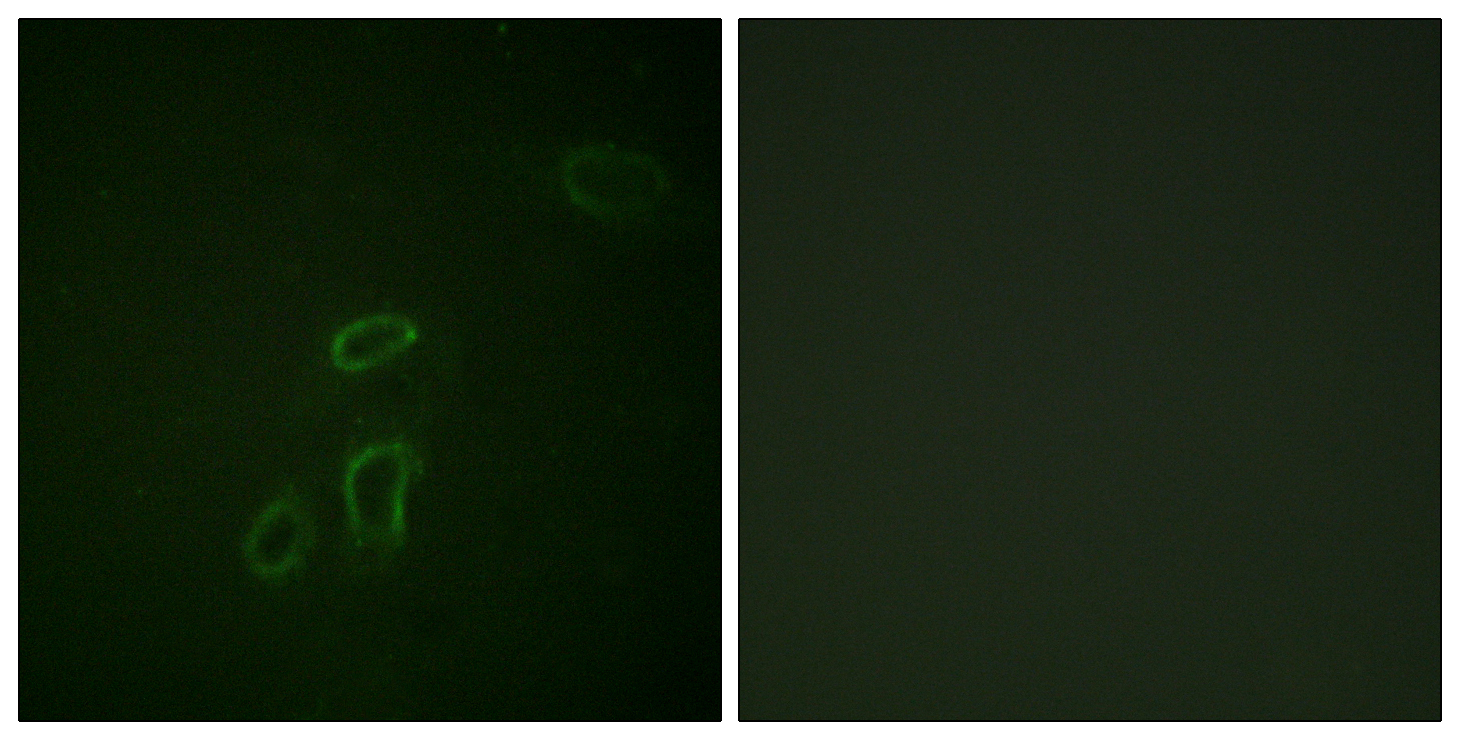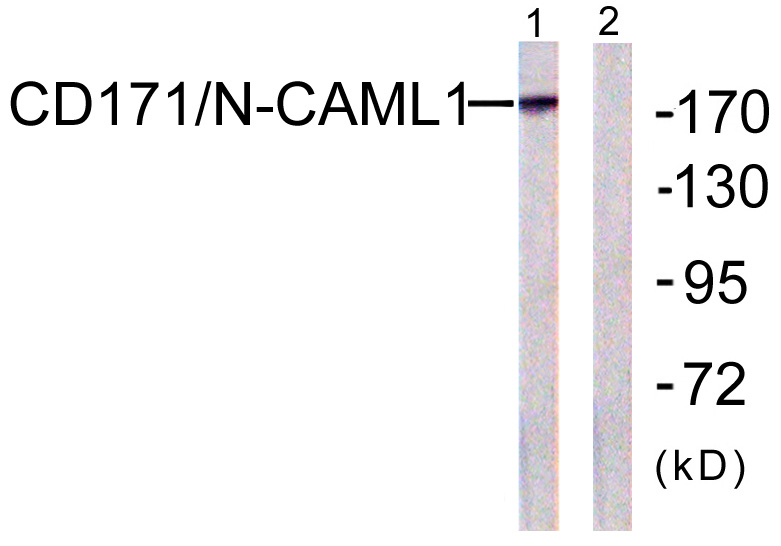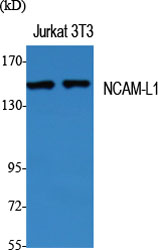产品名称
NCAM-L1 Rabbit Polyclonal Antibody
别名
L1CAM; CAML1; MIC5; Neural cell adhesion molecule L1; N-CAM-L1; NCAM-L1; CD antigen CD171
蛋白名称
Neural cell adhesion molecule L1
存储缓冲液
Liquid in PBS containing 50% glycerol, 0.5% BSA and 0.02% New type preservative N.
Human Gene Link
http://www.ncbi.nlm.nih.gov/sites/entrez?db=gene&term=3897
Human Swissprot No.
P32004
Human Swissprot Link
http://www.uniprot.org/uniprotkb/P32004/entry
Mouse Swissprot No.
P11627
Mouse Swissprot Link
http://www.uniprot.org/uniprot/P11627
Rat Gene Link
http://www.ncbi.nlm.nih.gov/sites/entrez?db=gene&term=50687
Rat Swissprot Link
http://www.uniprot.org/uniprot/Q05695
免疫原
The antiserum was produced against synthesized peptide derived from human CD171/N-CAML1. AA range:1147-1196
特异性
NCAM-L1 Polyclonal Antibody detects endogenous levels of NCAM-L1 protein.
稀释度
WB 1:500 - 1:2000. IHC 1:100 - 1:300. IF 1:200 - 1:1000. ELISA: 1:20000. Not yet tested in other applications.
宿主
Polyclonal, Rabbit,IgG
背景介绍
The protein encoded by this gene is an axonal glycoprotein belonging to the immunoglobulin supergene family. The ectodomain, consisting of several immunoglobulin-like domains and fibronectin-like repeats (type III), is linked via a single transmembrane sequence to a conserved cytoplasmic domain. This cell adhesion molecule plays an important role in nervous system development, including neuronal migration and differentiation. Mutations in the gene cause X-linked neurological syndromes known as CRASH (corpus callosum hypoplasia, retardation, aphasia, spastic paraplegia and hydrocephalus). Alternative splicing of this gene results in multiple transcript variants, some of which include an alternate exon that is considered to be specific to neurons. [provided by RefSeq, May 2013],
组织表达
Epithelium,Fetal brain,Liver,Pancreas,Plasma,
细胞定位
Cell membrane ; Single-pass type I membrane protein . Cell projection, growth cone . Cell projection, axon . Cell projection, dendrite. Colocalized with SHTN1 in close apposition with actin filaments in filopodia and lamellipodia of axonalne growth cones of hippocampal neurons (By similarity). In neurons, detected predominantly in axons and cell body, weak localization to dendrites (PubMed:20621658). .
信号通路
Axon guidance;Cell adhesion molecules (CAMs);
功能
disease:Defects in L1CAM are a cause of partial agenesis of the corpus callosum [MIM:304100]; a X-linked disorder.,disease:Defects in L1CAM are the cause of hydrocephalus due to stenosis of the aqueduct of Sylvius (HSAS) [MIM:307000]. Hydrocephalus is a condition in which abnormal accumulation of cerebrospinal fluid in the brain causes increased intracranial pressure inside the skull. This is usually due to blockage of cerebrospinal fluid outflow in the brain ventricles or in the subarachnoid space at the base of the brain. In children is typically characterized by enlargement of the head, prominence of the forehead, brain atrophy, mental deterioration, and convulsions. In adults the syndrome includes incontinence, imbalance, and dementia. HSAS is characterized by mental retardation and enlarged brain ventricles.,disease:Defects in L1CAM are the cause of mental retardation-aphasia-shuffling gait-adducted thumbs syndrome (MASA) [MIM:303350]; also known as corpus callosum hypoplasia, psychomotor retardation, adducted thumbs, spastic paraparesis, and hydrocephalus or CRASH syndrome. MASA is an X-linked recessive syndrome with a highly variable clinical spectrum. Main clinical features include spasticity and hyperreflexia of lower limbs, shuffling gait, mental retardation, aphasia and adducted thumbs. The features of spasticity have been referred to as complicated spastic paraplegia type 1 (SPG1). Some patients manifest corpus callosum hypoplasia and hydrocephalus. Inter- and intrafamilial variability is very wide, such that patients with hydrocephalus, MASA, SPG1, and agenesis of corpus callosum can be present within the same family.,disease:Defects in L1CAM are the cause of spastic paraplegia X-linked type 1 (SPG1) [MIM:303350]. Spastic paraplegia is a degenerative spinal cord disorder characterized by a slow, gradual, progressive weakness and spasticity of the lower limbs.,disease:Defects in L1CAM may contribute to Hirschsprung disease (HSCR) [MIM:142623]. It may do so by modifying the effects of a Hirschsprung disease-associated gene to cause intestinal aganglionosis.,function:Cell adhesion molecule with an important role in the development of the nervous system. Involved in neuron-neuron adhesion, neurite fasciculation, outgrowth of neurites, etc. Binds to axonin on neurons.,online information:L1CAM mutation Web Page,similarity:Belongs to the immunoglobulin superfamily. L1/neurofascin/NgCAM family.,similarity:Contains 5 fibronectin type-III domains.,similarity:Contains 6 Ig-like C2-type (immunoglobulin-like) domains.,
纯化
The antibody was affinity-purified from rabbit antiserum by affinity-chromatography using epitope-specific immunogen.



.jpg)
